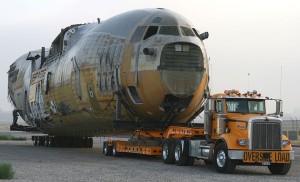While thinking about my new blog subject I bump into a turbulent territory Air transport industry. As we all know this sector has been through a decade-long recession and there is a lesson for all manufacturing sectors…
Crisis makes you develop out-of-box solutions, a bit like when do-or-die situation.
Aggressive competition focus on low prices and volatile fuel costs that affects dramatically airline companies’ stability. The reason of that is related to its robust structure and the fact that fuel is an important feature that can represent up to 60% of all costing. Downsizing, companies merge, high-tech materials to light up aircraft have been some of defensive strategies to avoid bankruptcy.
After optimizing process and protecting company by business strategies, there is a non conventional direction they found which is checking on the scrap and on maintenance hangars. Even though, aviation is a highly regulated sector notably on aircraft components, a tremendous tear down segment has merged to enforce profitability of second-hand aftermarket over original equipment manufacturers and the gap is up to 5% over last decade.
 Almost 70% of an end-life aircraft can be recovered by repairing parts and recycling material mostly metals. Aeroxchange in UK and Partsbase are controlling the European and North American MRO maintenance, repairing and overhaul markets and growing rapidly with over 12% of profits in 2012 compering to 2011. However, there is a 30% that is sent to disposal which is really representative considering that 600 aircrafts must be disassembled every year for the following 20 years.
Almost 70% of an end-life aircraft can be recovered by repairing parts and recycling material mostly metals. Aeroxchange in UK and Partsbase are controlling the European and North American MRO maintenance, repairing and overhaul markets and growing rapidly with over 12% of profits in 2012 compering to 2011. However, there is a 30% that is sent to disposal which is really representative considering that 600 aircrafts must be disassembled every year for the following 20 years.
A key factor in the equation to reminding in the aircraft market will be definitely reducing costs all over the life cycle of an aircraft which is around 25-35 years. That is where we realize that a traditional linear economy that promotes “extraction-production-consumption and waste” is no longer profitable for industry leaders that struggle in a high competitive market.
Nowadays, circular economy is a global practice that is explored by its components for instance, eco-design that consider that 80% of impacts of an aircraft is established at early stages of conception, energy savings and transfer to green ones to lift up advantage over other airlines because 40-60% of costs are related to fuel (taken from an article “aviation du futur” by Hèlene V. Gagnon, Bombardier, Novae, July 2012)
To win contracts to build a portion of the 12 000 airplanes that will be in demand during the next two decades, Aircraft builders understood that key factors of success will be high performance in fuel, design for dismantling, reduce frequency and time of maintenance and control life cycle to reduce internal cost.
To optimize the 30% of dump disposal of an end life airplane and deal with new composite materials with a new perspective, Second Cycle is willing to complete efforts of a local company that is developing an expertise on tear down market in Canada.
Is your company considering a circular economy project?
Contact us toll free : 1 833-280-2828


